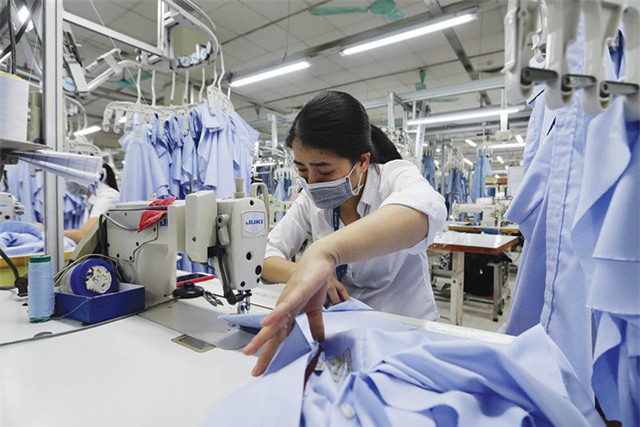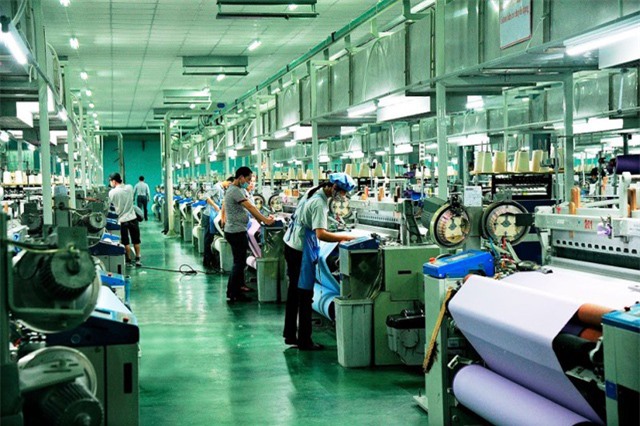After 9 months, the textile and garment export turnover reached 35 billion USD, up 21% over the same period in 2021. This is the highest growth rate in more than 10 years of the textile and garment industry. Especially if considering in 3 months, 6, 7 and 8, the textile and garment industry will continue to peak export.
But by mid-September, textile and garment exports have decelerated and many forecasts show that the fourth quarter of February and the beginning of 2023 will continue to face many challenges for Vietnam's textile and garment industry when the demand for importing this item in the world. is slowing down due to global economic difficulties, many technical requirements and regulations come into force.
Specifically, in the context of high inflation in some countries such as the US and EU, people limit their spending, and garment is one of the groups of goods that have been cut the most. Vietnamese textile and garment enterprises face fierce competition with countries with great experience in exporting textiles to the CPTPP and the EU such as China, Bangladesh, Turkey, India, etc.

The economic downturn is having a negative impact on Vietnam's textile and garment exports (Illustration image)
In the context of a fast-changing, unpredictable supply chain to make long-term planning from 1 to 2 years as before, businesses need to actively seek new partners, including small, stable orders to surpass them. overcome difficulties and successfully complete the set plan.
According to Mr. Nguyen Van Thu - General Director of Tuyen Quang LGG Garment Corporation, the situation of the order market is very difficult due to the recession effect of the economy. Foreign consumer markets are also changing. Keeping customers is the number 1 priority.
"Factories need to improve their management capacity, that is, the ability to quickly transform, produce both woven and knitted goods, or switch from the US market to Korea .. while still ensuring quality. volume, revenue," recommended Mr. Luu Tien Chung - Vice Chairman of Vietnam Textile and Apparel Association.
Meanwhile, Mr. Do Ngoc Hung - Vietnamese Trade Counselor in the US said that Vietnamese businesses also need to constantly review their supply chains and final products exported to the US to ensure that they are not affected. violate the regulations of the US market. Expected period October to December is the time when exporters receive orders from the United States. According to forecasts, the United States will continue to increase imports of consumer goods, including textiles.
Although the challenge is not small, according to Mr. Nguyen Xuan Duong - Vice Chairman of the Vietnam Textile and Apparel Association (Vitas), most businesses are currently operating 80-90% of their production capacity. Mr. Duong assessed that he could rest assured about the orders of textile and garment enterprises.
Challenge rules of origin
In addition to declining import demand, the requirement for traceability of cotton, fabric and yarn from new-generation free trade agreements are also challenges that Vietnamese textile and garment enterprises are facing.
According to statistics, Vietnam's textile and garment must import up to 80% of fabrics for export garment. The ability to localize Vietnam's textile and garment export products is not large and has not brought much added value to goods. In the past period, the localization rate of the textile and garment industry reached about 46-47%. Currently, the textile industry is still heavily dependent on imported raw materials.
In 2021, imports of textile materials and accessories all increased quite high compared to the previous year, of which the import of fabrics of all kinds of the whole country reached 14.3 billion USD, an increase of 20.62% compared to 2020. In the 8 months of 2022, on average, Vietnam has to spend more than 2 billion USD per month to import raw materials, including: cotton, textile fibers, fabrics of all kinds, raw materials for the textile, garment, leather and shoe industries. .
Mr. Nguyen Xuan Duong - Vice Chairman of the Vietnam Textile and Apparel Association (Vitas) said that the issue of traceability of cotton was a problem that the textile industry, the association ... had anticipated. Some orders have been subject to traceability checks at US Customs, but most can be imported normally. However, we also have to ask the question of how to proactively source materials.

Chain production with the strong development of the textile supporting industry is considered a prerequisite for the sustainability of the textile industry (Artwork).
"Currently, the localization rate in the export textile and garment industry is over 50%. Compared to 10 years ago, we have had a relatively good growth when we previously depended on over 70% of foreign countries. Our orientation is step by step how to proactively source about 80-90% of local raw materials, firstly to actively produce, secondly to enjoy tax rates of trade agreements. (if there is a local source of raw materials, the tax rate will be zero), "said Mr. Duong.
Mr. Duong cites that many businesses have taken the initiative in raw materials on the spot. For example, with cotton, which used to be mostly imported from Korea or China, now there are 3 factories in the North supplying cotton cushions for jackets: TNG, Song Hong... In addition, some state-owned manufacturers. Fabrics and accessories for the garment industry have also provided a basic part of items that can meet export standards.
According to the assessment, the textile and garment industry has achieved impressive export figures, a new record every year, but in fact, when there is no real manufacturing industry, that is, production in a chain with the strong development of the supporting industry. textile support is a lot like "building a castle in the sand". Only when there is strong domestic production from the first stages in the chain, will the added value of a textile product be great and really contribute to the comprehensive and sustainable development of the Vietnamese economy.
According to VTV